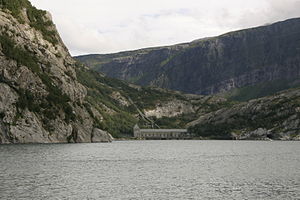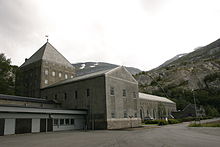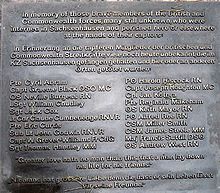- Operation Musketoon
-
Operation Musketoon Part of Second World War
Glomfjord power plant at the end of GlomfjordDate 11–21 September 1942 Location Glomfjord, Norway Result Destruction of the Glomfjord power plant Belligerents  United Kingdom
United Kingdom
 Norway
Norway Nazi Germany
Nazi GermanyCommanders and leaders Captain Graeme D. Black Generaloberst Nikolaus von Falkenhorst Strength 10 British Commandos from No. 2 Commando
2 men from the Norwegian Independent Company 11st Battalion, 340th Infantry Regiment
233rd Artillery Regiment
both from the
196th Infantry Division[1]Casualties and losses Eight of the commandos died, either from wounds or execution Two dead,
one woundedOperation Musketoon was the codeword for an Anglo-Norwegian raid in the Second World War. The operation was mounted against the German-held Glomfjord power plant in Norway between 11–21 September 1942.
The raiding party consisted of two officers and eight men from No. 2 Commando, and two men of the Norwegian Armed Forces in exile who were part of the Special Operations Executive. Crossing the North Sea by submarine, on arrival in Norway they successfully attacked and sufficiently damaged the plant; it remained inoperative for the remainder of the war.
To evade German search parties, the commandos split into two groups. One group of four men safely reached Sweden and were eventually repatriated back to the United Kingdom. The second group were captured; one man died of his wounds and the other seven were taken to Germany, interrogated and then executed at Sachsenhausen concentration camp.
Contents
Background
After the British Expeditionary Force had been evacuated from Dunkirk in 1940, Prime Minister Winston Churchill called for a force to be assembled and equipped to inflict casualties on the Germans and bolster British morale. Churchill told the joint Chiefs of Staff to propose measures for an offensive against German-occupied Europe, and stated: "They must be prepared with specially trained troops of the hunter class who can develop a reign of terror down the enemy coast."[2] One staff officer, Lieutenant-Colonel Dudley Clarke, had already submitted such a proposal to General Sir John Dill, the Chief of the Imperial General Staff. Dill, aware of Churchill's intentions, approved Clarke's proposal.[2] Three weeks later the first commando raid took place. The raiders failed to gather any intelligence or damage any German equipment; their only success was in killing two German sentries.[2]
No. 2 Commando was a commando unit of the British Army during the Second World War. The original No. 2 Commando, unlike the other commando units, was formed from volunteers from across the United Kingdom and was always intended to be a parachute unit. On 22 June 1940, No. 2 Commando was turned over to parachute duties, and, on 21 November, was re-designated as the 11th Special Air Service Battalion and eventually 1st Parachute Battalion.[3] The first No. 2 Commando did not carry out any operations before being turned over to parachute duties.[4] After its re-designation as the 11th Special Air Service Battalion, a second No. 2 Commando was formed.[4] This new No. 2 Commando was under the command of Lieutenant Colonel Augustus Charles Newman,[5] Their first action was when two Troops supported No. 3 Commando in the Vaagso raid in December 1941. This was followed by the St Nazaire Raid in March 1942.[6] The next action involving men of No. 2 Commando was Operation Musketoon. The objective was to destroy the Glomfjord power plant at Glomfjord, south of Narvik, which supplied an aluminium plant in the area.[7]
The Glomfjord power plant was built in 1918, at the end of Glomfjord. It is located on a plateau that drops straight down to the sea. The plant comprised three buildings: the longest was the machinery hall; the middle building housed the control room and offices; and the last building was three-storeyed and known as the apparatus house.[8] It was a hydroelectric power plant supplied by two water pipes coming down the mountain from inland lakes. Apart from the aluminum factory, the power plant also supplied power to local villages.[9]
Mission
The men selected for Operation Musketoon were two officers and eight men from No. 2 Commando and two Norwegian corporals from the Norwegian Independent Company 1, part of the Special Operations Executive. The raid was commanded by Captain Graeme Black, from Ontario in Canada. The second in command was Captain Joseph Houghton. The other men from No. 2 Commando were: Company Sergeant Major Miller Smith, Lance Sergeant Richard O'Brien, Lance Bombadier William Chudley and privates John Fairclough, Cyril Abram, Eric Curtis, Reginald Makeham and Fred Trigg. The two Norwegian corporals were Erling Djupdraet and Sverre Granlund.[10] For a fortnight before leaving for Norway, the team had been training on a large country estate in Scotland.[11] During the planning stage the commandos were supposed to be picked up after the raid, by a Short Sunderland flying boat. This was cancelled before they left, due to risks to the aircraft. Instead they would head for neutral Sweden.[12] To assist in this, each man was issued with special equipment, which included a silk map of Norway and Sweden, a rice paper map of Russia and Norwegian Kroner notes. They also carried two compasses (one sewn into each collar tab), a hacksaw blade, a fighting knife and a M1911 Colt pistol. The only other small arm taken was a silenced Sten gun, carried by Captain Houghton.[13]
Sea crossing
To transport the raiders across the North Sea, a Minerve class submarine, Q186 Junon, under the command of Commander Querville and belonging to the Free French Navy was used. Junon was selected because in silhouette it had the appearance of a German U-Boat, which could be advantageous if sighted on the surface. The submarine left the Orkney Islands at 11:40 on 11 September 1942, under escort in British waters by HMS Sturgeon, HMS Tigris and HMS Thunderbolt.[13] Junon crossed the North Sea undetected and, nearing Glomfjord, rose to periscope depth. Checking the horizon they discovered that a fishing boat was trailing them; they crash dived, but this sighting does not appear to have compromised the operation.[10] The commander of the raid, Captain Black, had decided against a frontal assault since he suspected any German defences would be expecting just that. The submarine entered the Bjaerangsfjord just south of Glomfjord on 15 September.[14]
Raid
The submarine had settled on the bottom of the fjord until darkness and surfaced at 21:15 to put the commandos ashore by dinghy. Safely reaching the shore they hid their dinghy under some stones and moss. They then set out across the mountains to Glomfjord. Reaching the Black Glacier undetected, Captain Houghton and one of the Norwegians, Granlund, went ahead to carry out a reconnaissance of the area. When the reconnaissance party returned they started to climb the mountain. This became an increasingly difficult climb: at one stage they had to traverse a near vertical rock face before reaching the summit.[10] The commandos were unaware that their presence was already suspected. A German topographical party was in the area, and its commander, Leutnant Wilhelm Dehne, had spotted some unidentified figures above the Glomfjord. Later he discovered some Player's cigarette packets and the remains of a camp. Fortunately for the commandos, his route back to Glomfjord took him away from where they were waiting, in a hideout overlooking the power plant.[10]
Resting in their hide for the next day, the commandos went over their plan of attack and withdrawal from the area. They left their hideout at 20:00 on 17 September to start their attack on the power plant. On their approach they detected a small craft on the fjord; fearing they would lose the element of surprise if seen, they retreated back up the hill. By dawn they had not been able to reach their previous hideout; while they were in an exposed location they decided to stay where they were until that night. The commandos had by now started to run short of supplies, and Captain Black ordered the attack to proceed that night, 19/20 September, no matter what.[10]
The commandos were divided into two groups for the attack. One group consisting of Lance Sergeant O'Brien, Lance Bombadier Chudley and Private Curtis targeted two high-pressure water pipes 7 feet (2.1 m) in diameter, leading from the top of the mountain into the plant. Reaching their objective, they planted their plastic explosives in a pattern to blow a 3 feet (0.91 m) gap in the pipes. Attaching a 30-minute delayed fuse, they waited to hear the explosives going off in the plant, which was the signal to activate their fuse.[15]
The other nine commandos had set out for the rear of the power plant. Seven of them entered the machinery hall, leaving two commandos to guard the exit. The commandos who entered the power plant discovered that the Germans had left the control room. Only a Norwegian engineer was on duty. Sergeant Smith and Private Fairclough were detailed to plant their explosives amongst the machinery in the power house,[16] while the other commandos located the place where the Norwegian work force worked and slept. The workers were gathered together and ordered to leave the power plant via an access tunnel over 1 mile (1.6 km) in length, which was also the only land route between the power plant and the villages in the fjord. On their approach to the tunnel a German guard was killed by the Norwegian Granlund and another ran off down the tunnel to raise the alarm. To delay any German reinforcements, the commandos left smoke bombs in the tunnel. By this time the commandos in the power plant had set their plastic explosives with 10-minute delay fuses on the plant's turbines and generators.[10]
Capture
Upon hearing the explosions at the power plant, Lance Sergeant O'Brien's group activated its own explosives. Both groups then withdrew back into the hills, just as German reinforcements were arriving at the plant. The Germans were unwilling to enter the tunnel, fearing it might be booby trapped, so they used boats belonging to the villagers to bypass the tunnel and reach the power plant. The Norwegian Granlund had pressed on ahead of the main group trying to locate a foot bridge to aid their escape. He did locate a mountain hut occupied by three Norwegians who he asked for directions, the best they could do was draw him a map. Granlund left to try and locate the bridge but returned to the hut soon after being unable to find it in the dark. He arrived back at the same time as Captain Houghton and the other Norwegian, Djupdraet all three entered the hut. Unknowingly while Granlund had been away two Germans had arrived at the hut and were busy questioning the occupants. In the ensuing fight, one of the Germans was killed and the other wounded. Djupdraet was also wounded, stabbed in the stomach with a bayonet.[10]
The remaining commandos arrived at the scene and administered first aid to Djupdraet. His wound was so severe, they decided to leave him behind to get treatment. The remaining commandos now split into two groups to evade the German search parties and made their way further up the mountain. One group, consisting of Lance Sergeant O'Brian, Corporal Granlund, and privates Fairclough and Trigg, went north around the mountains. The second group of Captains Black and Houghton, CSM Smith, Lance Bombadier Chudley, and privates Curtis, Abram and Makeham, took the southern route. The second group were discovered by the Germans who opened fire, wounding Captain Houghton in the right arm. Trapped and surrounded they were forced to surrender. The O'Brian group split up into two smaller groups, the Norwegian Granlund setting off by himself. They all eventually reached Sweden without further incident and all four were repatriated by plane to RAF Leuchars. Of the other eight, Djupdraet died of his wounds in hospital, three days after the raid. The other seven prisoners of war were sent to Germany.[10]
The seven were first sent to Colditz Castle and managed to make contact with the other prisoners, giving them their names which were passed on to MI5 in London.[17] On 13 October 1942 they were removed from Colditz and taken to the SS-Reichssicherheitshauptamt (RHSA) headquarters in Berlin, where they were interrogated one by one by Obergruppenführer Heinrich Müller.[18] They remained in Berlin until 22 October, when they were taken to the Sachsenhausen concentration camp. On the next day, 23 October, they were all shot in the back of the neck and their bodies cremated.[19] These commandos were the first to fall victim to Adolf Hitler's Commando Order issued on 18 October 1942, which called for the execution of all commandos after capture.[20] The official German story given to the Red Cross was that the seven men had escaped and not been recaptured.[21]
Aftermath
The raid was considered a great success, as it seemed likely that the power plant would remain out of action until after the end of the war.[22] After returning to the United Kingdom and a debriefing, Lance Sergeant Richard O'Brien was awarded the Distinguished Conduct Medal,[23] and privates Trigg and Fairclough were both awarded the Military Medal.[24] Of the four survivors, Corporal Granlund was killed in February 1943, along with one British and four Norwegian commandos as part of Operation Seagull, when the Norwegian submarine Uredd sank off the Norwegian coast.[25] Private Trigg was killed in Italy and is buried at the Cassino memorial. Lance Sergeant O'Brien and Private Fairclough survived the war.[10][26]
After the war, on 15 November 1945, Captain Graeme Black was awarded the Distinguished Service Order and Captain Joseph Houghton the Military Cross backdated to 22 November 1942.[27] Black and Houghton and the other five men of Operation Musketoon are commemorated on the Sachsenhausen Concentration Camp memorial plaque and the Brookwood Memorial.[28] The Brookwood memorial is for men and women of the British and Commonwealth armies who died during the Second World War and have no known grave.[29]
The German commander in Norway, Generaloberst Nikolaus von Falkenhorst, was captured after the war and tried by a British military court for his part in carrying out the Commando Order. Found guilty on all eight charges of urging the forces under his command to kill men captured in commando raids or handing prisoners of war over to the Sicherheitsdienst (SD) for execution, he was sentenced to death, which was later commuted to life imprisonment.[30]{He was released in 1953 and died in 1968}
References
- Notes
- ^ Schofield, p.70.
- ^ a b c Haskew, p.47
- ^ Shott & McBride, p.4
- ^ a b Moreman, p.91
- ^ Moreman, p.15
- ^ "History of No. 2 Commando". Commando Veterans Association. http://www.commandoveterans.org/history_2cdo.html. Retrieved 7 July 2010.
- ^ Messenger, p. 165
- ^ "Glomfjord kraftstasjon". The University Library of Tromsø. http://www.ub.uit.no/baser/arkinord/categories.php?cat_id=148. Retrieved 7 July 2010.
- ^ Schofield, p.20
- ^ a b c d e f g h i "Operation Musketoon — Glomfjord - 15/21 September 1942". Combined Operations. http://www.combinedops.com/glomfjord.htm. Retrieved 7 July 2010.
- ^ Schofield, p.19.
- ^ Schofield, p.22.
- ^ a b Schofield, p.20.
- ^ Schofield, p.31
- ^ Schofield, p.46
- ^ Mountbatten, p.23
- ^ Schofield, p.135
- ^ Schofield, p.141
- ^ Schofield, p.143
- ^ "The Commanders". Commando Veterans Association. http://www.commandoveterans.org/history_2cdo_b.html. Retrieved 8 July 2010.
- ^ Russell, pp.33–34
- ^ Mountbatten, p.24
- ^ London Gazette: (Supplement) no. 35929. p. 1118. 5 March 1943. Retrieved 9 July 2010.
- ^ London Gazette: (Supplement) no. 35853. p. 210. 5 January 1943. Retrieved 9 July 2010.
- ^ Schofield, p.150
- ^ "Frederick Trigg". Commonwealth War Graves Commission. http://www.cwgc.org/search/casualty_details.aspx?casualty=2098933. Retrieved 10 July 2010.
- ^ London Gazette: (Supplement) no. 37349. p. 5574. 13 November 1945. Retrieved 9 July 2010.
- ^ "Graeme Black". Commonwealth War Graves Commission. http://www.cwgc.org/search/casualty_details.aspx?casualty=2145260. Retrieved 10 July 2010.
- ^ "Brookwood Memorial". Commonwealth War Graves Commission. http://www.cwgc.org/search/cemetery_details.aspx?cemetery=2012400&mode=1. Retrieved 10 July 2010.
- ^ Russell, p.32
- Bibliography
- Chappell, Mike (1996). Army Commandos 1940–1945. Elite Series # 64. Oxford: Osprey Publishing. ISBN 1855325799.
- Haskew, Michael E (2007). Encyclopaedia of Elite Forces in the Second World War. Barnsley, Yorks: Pen and Sword. ISBN 9781844155774.
- Messenger, Charles (1991). The Last Prussian: A Biography of Field Marshal Gerd von Rundstedt, 1875–1953. xxxxxxxx: Brassey's. ISBN 9780080367071.
- Moreman, Tim (2006). British Commandos 1940–46. Oxford: Osprey Publishing. ISBN 9781841769868.
- Mountbatten, Louis (2007). Combined Operations: The Official Story of the Commandos. xxxxxx: Read Books. ISBN 1406759570.
- Lord Russell of Liverpool (2008). The Scourge of the Swastika: A History of Nazi War Crimes During World War II. xxxxxxxx: Skyhorse Publishing Inc. ISBN 1602392811.
- Schofield, Stephen (1964). Musketoon: commando raid, Glomfjord, 1942. University of Michigan.
- Shortt, James; McBride, Angus (1981). The Special Air Service. Oxford: Osprey Publishing. ISBN 0850453968.
External links
 British Commando raids of the Second World War
British Commando raids of the Second World WarA Abstention · Agreement · Ambassador · Anklet · Archery · Aquatint · Aflame · Anglo · Amherst · Archway · Abercrombie · Acid Drop · Albumen · AstrakanB C D E ExporterF G H Hardtack · Huckaback · Hawthorn · Houndsworth
I J K L M N P R Rimau · Roast · Roundabout · Rumford
S T Categories:- Conflicts in 1942
- Battles and operations of World War II involving Norway
- Operations involving special forces
- World War II British Commando raids
- 1942 in Norway
- Norwegian resistance movement
- Military operations of World War II involving Germany
- History of Nordland
- Sachsenhausen concentration camp
Wikimedia Foundation. 2010.



